°Arcus°
Home » Creation stories » Polynesia and Micronesia
CREATION STORIES FROM POLYNESIA AND MICRONESIA
HACHAMORI
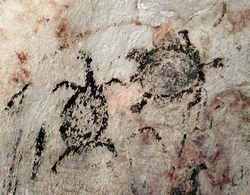
In the beginning, Na Arean manifested as "a cloud that floats in nothingness." Suddenly, a thought appeared within his mind, and he fashioned water in one hand, then mud. He rolled the mud and water into a ball and sat upon it, like a bird upon an egg.
Some time later, his head expanded until, on the third day, a man burst forth. He gave this figure the name Na Arean the Younger, and ordered him to sit within one of the creator's eyes. Thereafter, Na Arean the Younger was ordered down to earth, with a task of finding the centre. This was marked by a tooth which Na Arean the Elder had plucked from his mouth. By means of the hollow tooth, Na Arean the Younger found the navel of the earth.
At the centre of the earth, Na Arean the Younger discovered that everything was cramped together in the darkness which existed there, a result of Na Arean the Elder sitting upon it. He began to organise the earth until the heavens were above, allowing the sun to send its light through the hollow tooth.

HAWAI'I
According to the Kumulipo, a song from Hawai'i which tells of the creation of the cosmos, the world was created during a series of nights forming one cosmic night. There are sixteen wā, with the first seven covering the era of pō ("darkness"), an age of spirit during which the existence of the earth - or even the material universe - is ambiguous. Various aspects of the cosmos are created over the course of these wā: -
- Sea urchins and limu (seaweed), with ferns representing the limu on land.
- Seventy-three types of fish, including Nai'a (porpoise), Mano (shark), Moi and Weke. As is the case for the limu and ferns, plants with names similar to those of the fish species are also created as their protectors.
- Fifty-two types of birds, as well as certain flying insects. These include Lupe, 'Iwa (frigate bird), Noio (Hawaiian noddy tern), Io (hawk), Nene (goose), Pueo (owl), Pe'elua (caterpillar) and Pulelehua (butterfly).
- Insects, crustaceans and reptiles. These include Honu (sea turtle), Opeope (jellyfish), Ula (lobster), Mo'o (lizard), Kuhonua (the maile vine) and 'Ohe'ohe (bamboo).
- Kalo (taro).
- Uku (flea) and 'Iole (rat).
- 'Īlio (dog) and Pe'ape'a (bat).
- Four gods: La'ila'i (Female), Ki'i (Male), Kāne (God) and Kanaloa (Octopus).
- The first humans are born from the brain of La'ila'i after her union with Ki'i.
- Four children of La'ila'i and Kāne - La'i'olo'olo, Kamaha'ina, Kamamule and Kamakalua - and three children of La'ila'i and Ki'i - Ha'i, Hali'a and Hākea (collectively known as Po'olua, claiming descent from both fathers).
- Homage to the Moa.
- Honours Wākea and his descendants: he is the father of Hāloa, ancestor of all people.
- Honours the lineage of Papa, Hāloa's mother.
- Li'aikūhonua and Keakahulihonua become the parents of Laka.
- Honours Haumeanui'āiwaiwa and her lineage, as well as Māui and his siblings.
- Forty-four generations of Māui's line down to Pi'ilani, the 15th Mō'ī of the island of Maui.
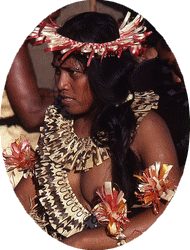
I-KIRIBATI (GILBERTESE)
In the beginning, Nareau ordered sand and water to produce offspring. One of the children born from this union was Nareau the Younger. Nareau the Younger carried out an act of patricide, slaying the creator and making use of his body to fashion the cosmos, after he found the sky too heavy to allow the children he had brought into being to live well. From Nareau's eyes, the sun and moon were made. His spine was placed on Samoa, becoming the axis mundi.
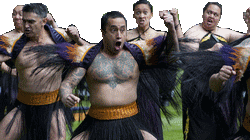
MĀORI
RANGI AND PAPA
According to one of these, creation was accomplished by the primordial couple: -
- Rangi, Ranginui, Raki or Rakinui - the sky father; and
- Papa or Papatūānuku - the earth mother.
In the beginning, these two lay cleaving together tightly. Many children, all sons, were the product of their union - though, given the embrace between their parents, this ever-increasing group were reduced to living in decidedly gloomy and cramped conditions. Eventually, the sons become desperate, and hold a meeting to discuss possible solutions to the impasse. The eldest and most aggressive of their number, Tū or Tūmatauenga ("Tū of the angry face," god of war, appropriately enough: this role is taken by the god Maru on the South Island), proposes that they kill their parents. However, Tāne, the patron deity of birds and forests, suggests instead that they push Rangi and Papa apart, leaving themselves below with Papa to nurture them, while Rangi was to be set far above them. The consensus supports Tāne.
This proves difficult to accomplish, however, with Rongo (god of agricultue), Tangaroa (god of the sea) and Haumia-tiketike (god of wild food) all fail. It is left to Tāne to try to find a way to carry out his plan, which he does, by the ingenious method of lying on his back and using his legs, as opposed to his brothers, who attempted the feat with their arms.
TĀWHITIMĀTEA AND THE WAR OF HEAVEN AND EARTH
The one dissenting voice in all of this was Tāwhirimātea, the god of storms and winds, who is greatly moved by the cries of Rangi and Papa as they are separated. He decides to leave the earth and join his father in the heavens, where he proceeds to father a group of children, patrons of the winds. These he fashions into an army, with which he attempts to overthrow his brothers and claim the earth as his own. Tangaroa is attacked, causing the formation of tsunamis and whirlpools, causing him to flee in panic. His son Punga has two sons, Tū-te-wehiwehi or Tū-te-wanawana and Ikatere, who are the ancestors of reptiles and fish respectively. These groups of animals, in rout as a result of Tāwhirimātea's onslaught, seek refuge in the forests and seas. As a result of this, Tāne supplies the children of Tūmatauenga with the means to capture Tangaroa's descendants, resulting in a retaliatory flooding of the land.
The next phase of the war sees Tāwhirimātea attacking Rongo and Haumia-tiketike, who are subsequently hidden by Papa, leading Tāwhirimātea to instead go after Tūmatauenga, only to meet with stout, unyielding resistance. This angers Tūmatauenga, who seeks to avenge himself on Tāne as the ultimate cause of this turmoil. Tūmatauenga's offspring soon reduce Tāne's birds to prey, before they proceed to gain mastery over the fish in the sea. Tūmatauenga eventually manages to dig Rongo and Haumia-tiketike out of their hiding place, thus setting in motion the order of things, with humans (Tūmatauenga's descendants) predominant over the offspring of the younger brothers of that fierce deity.
The children of Tūmatauenga thus represent the earliest inhabitants of New Zealand, and they thrived until the time of the great hero Māui and his brothers.
HINE-NUI-TE-PŌ
Once the separation of Rangi and Papa was accomplished, their children had the opportunity to select which gender they wished to be. As a result, sexual reproduction became a possibility, and Tāne in particular was keen to secure a bride for himself. To this end, he gathered his brothers at Kurawaka (the puke or pubis of Papa) and used the red earth to form an image of a woman. Tāne breathed the manawa ora or breath of life - granted by the primal, uncreated god of light Ao and brought back by Rehua, a revered god who dwells among the stars in Rangi-tuarea, the highest heaven - into this figure, whereupon she sneezed into life. She was given the name Hine-ahuone (the "Great Woman who comes from the Soil"). By her, Tāne became the father of, among others, Hine-nui-te-pō (the "Great Woman of night"), whom he subsequently married. Realising that her husband and her father are one and the same, she descends to the subterranean land of Pō ("darkness"), ashamed. It is there that she gains control over the souls of men in a battle of wills against Tāne, who seeks to lead them to the light.
MARSHALL ISLANDS
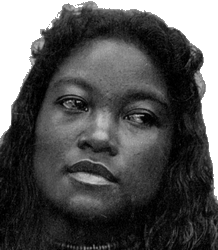
In the beginning, Lowa, the uncreated one, existed alone within the primordial waters. He made a humming sound, which brought reefs and sandbanks into existence. Thereafter, he repeated this process, producing animals and plants. He made four gods to have dominion over the four directions, and created a gull god to circle the sky.
Lowa also made a man, who placed the island in a basket of coconut leaves and attempted to place them in some sort of order, with the Carolines in the west and the Marshalls in a line. Only Namorik fell from the basket and went awry. Once this was done, the man discarded the basket, which became the island of Kili. Of all the islands, only Bikini possessed coconut trees.
Finally, Lowa sent tattooists to the islands to give each creature a distinctive mark.
NAURU
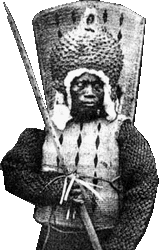
In the beginning, there were only two things in existence: the sea; and the spider Areop-Enap. Areop-Enap, seeking sustenance in this dark world, discovered a huge clam, which swallowed him. Inside the clam, he found a snail or shellfish, which he placed under his arm and fell asleep for three days, imbuing the snail with a portion of his power. Thereafter, he found a second, larger snail and repeated the process.
After he awakened a second time, Areop-Enap asked the smaller snail to try to pry open the clam's shell. As it moved, it left a phosphorescent trail, enabling Areop-Enap to catch sight of a white worm or caterpillar named Rigi. Areop-Enap cast an enchantment on Rigi, enabling him to gain the strengh necessary to open the clam. The clam resisted, however, with Rigi's sweat pooling in the shell, forming a lake and then a sea. The clam was killed by the salty water and opened, whereupon Areop-Enap fashioned the earth from the lower part of the shell and the sky from the upper portion. The smaller snail he placed to the west of the sky, where it became the moon, and the larger snail in the east, forming the sun. Islands were created from the flesh of the clam, which were clothed by Areop-Enap with vegetation formed from his webs. Last of all, he turned to Rigi, but was saddened to discover that he had drowned in the sea of sweat. Areop-Enap wrapped him in a silk cocoon and hung him from the sky-shell, where he became the Milky Way.
The next stage was to populate the earth, which Areop-Enap did by creating humans from stones to support the sky, before discovering other life forms there. He created a bird from the dirt beneath his nails and set it about the task of annoying the creatures, which caused them to call upon one another to kill the pestilent fowl. Thus, Areop-Enap learned the names of the earth's inhabitants.
SAMOA
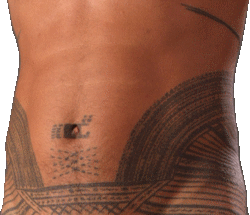
Tagaloa, also rendered Tagaloa-lagi ("Tagaloa of the heavens") first fashioned the nine heavens or lagi tua iva, from which he rolled two stones, which became the islands of Savai'i and Upolu. He also send down a vine which became infested with maggots, which eventually developed into humans.
Tagaloa had a number of children, including Moa, Lu, Losi, Alo'alo and Fe'e. His daughter Lu had a son, Young Lu, who quarreled with Moa, after which he fled to earth, which he named Samoa.
Alo'alo, meanwhile, married Sina, daughter of Tui Fiti. Fe'e ("octopus") was a war god, while Losi became a culture hero. This giant was tasked with fishing on behalf of the gods, but he tricked them, laying one of his catch at their doors causing them to slip. This enabled him to steal a portion of the taro plant and smuggle it to earth, where it became a staple of Samoan cuisine.
TONGA

In the beginning, all was dark. Vatea and Tonga-iti fought over their respective claims to a child. It was eventually decided that they would cut the child in two. Vatea, allocated the top half, created the sun from it by compacting it into a ball. Tonga-iti sought to emulate this, but his ball continued to lie on the ground, bleeding. This eventually became the moon.
It was Tangaloa who, according to inhabitants of Vava'u, raised the land of Hunga from the bottom of the ocean with his fish hook. The other islands were drawn up by heroes and demigods collectively known as Maui.
Puloto is the unseen realm of the dead, ruled by Hikule'o. It could be reached over the sea.
TRUK
In the beginning, the sky god dwelt above. He had a daughter, Ligoububfanu. Ligoububfanu was the mother of all life on earth. The face of her eldest child is stamped on the coconut.
TUAMOTU
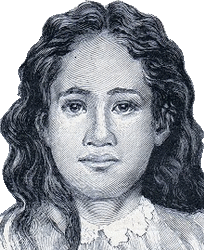
In the beginning, Kiho dwelt in an empty region beneath Havaiki. His only companion was his Activating Self. Kiho thought of what was to be, and the Activating Self made it into a reality. Kiho created the dark waters, then the night time, the world of spirits. Thereafter, he made the day world, followed eventually by the sky world.
Thereafter, he awoke and things came to be. In his empty home beneath Havaiki, things began to awaken after him. He created the primordial waters and called upon his Activating Self to cause earth tremors within the rocky depths of Havaiki. His eyes became flames and he floated up, while the Activating Self lay upon the waters. Then he brought the night and day worlds into reality. He continued to rise, making the heavens and earth, then finally Atea-ragi and Fakaho-tuhenua, the male and female forces.
Thereafter, Kiho ordered what he had made, while his Activating Self took on physical form, becoming the ruler of the world. Kiho, meanwhile, re-entered his primordial state of non-being.
